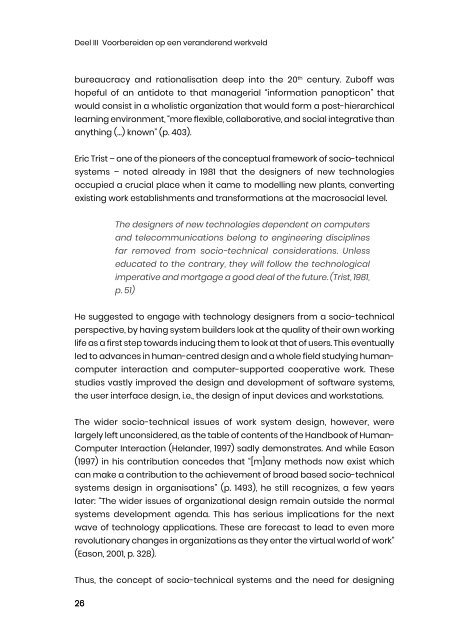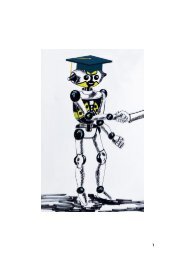13. Digital transformations and their design – renewal of the socio-technical approach
Create successful ePaper yourself
Turn your PDF publications into a flip-book with our unique Google optimized e-Paper software.
Deel III Voorbereiden op een ver<strong>and</strong>erend werkveld<br />
bureaucracy <strong>and</strong> rationalisation deep into <strong>the</strong> 20 th century. Zub<strong>of</strong>f was<br />
hopeful <strong>of</strong> an antidote to that managerial “information panopticon” that<br />
would consist in a wholistic organization that would form a post-hierarchical<br />
learning environment, “more flexible, collaborative, <strong>and</strong> social integrative than<br />
anything (…) known” (p. 403).<br />
Eric Trist <strong>–</strong> one <strong>of</strong> <strong>the</strong> pioneers <strong>of</strong> <strong>the</strong> conceptual framework <strong>of</strong> <strong>socio</strong>-<strong>technical</strong><br />
systems <strong>–</strong> noted already in 1981 that <strong>the</strong> <strong>design</strong>ers <strong>of</strong> new technologies<br />
occupied a crucial place when it came to modelling new plants, converting<br />
existing work establishments <strong>and</strong> <strong>transformations</strong> at <strong>the</strong> macrosocial level.<br />
The <strong>design</strong>ers <strong>of</strong> new technologies dependent on computers<br />
<strong>and</strong> telecommunications belong to engineering disciplines<br />
far removed from <strong>socio</strong>-<strong>technical</strong> considerations. Unless<br />
educated to <strong>the</strong> contrary, <strong>the</strong>y will follow <strong>the</strong> technological<br />
imperative <strong>and</strong> mortgage a good deal <strong>of</strong> <strong>the</strong> future. (Trist, 1981,<br />
p. 51)<br />
He suggested to engage with technology <strong>design</strong>ers from a <strong>socio</strong>-<strong>technical</strong><br />
perspective, by having system builders look at <strong>the</strong> quality <strong>of</strong> <strong><strong>the</strong>ir</strong> own working<br />
life as a first step towards inducing <strong>the</strong>m to look at that <strong>of</strong> users. This eventually<br />
led to advances in human-centred <strong>design</strong> <strong>and</strong> a whole field studying humancomputer<br />
interaction <strong>and</strong> computer-supported cooperative work. These<br />
studies vastly improved <strong>the</strong> <strong>design</strong> <strong>and</strong> development <strong>of</strong> s<strong>of</strong>tware systems,<br />
<strong>the</strong> user interface <strong>design</strong>, i.e., <strong>the</strong> <strong>design</strong> <strong>of</strong> input devices <strong>and</strong> workstations.<br />
The wider <strong>socio</strong>-<strong>technical</strong> issues <strong>of</strong> work system <strong>design</strong>, however, were<br />
largely left unconsidered, as <strong>the</strong> table <strong>of</strong> contents <strong>of</strong> <strong>the</strong> H<strong>and</strong>book <strong>of</strong> Human-<br />
Computer Interaction (Hel<strong>and</strong>er, 1997) sadly demonstrates. And while Eason<br />
(1997) in his contribution concedes that “[m]any methods now exist which<br />
can make a contribution to <strong>the</strong> achievement <strong>of</strong> broad based <strong>socio</strong>-<strong>technical</strong><br />
systems <strong>design</strong> in organisations” (p. 1493), he still recognizes, a few years<br />
later: “The wider issues <strong>of</strong> organizational <strong>design</strong> remain outside <strong>the</strong> normal<br />
systems development agenda. This has serious implications for <strong>the</strong> next<br />
wave <strong>of</strong> technology applications. These are forecast to lead to even more<br />
revolutionary changes in organizations as <strong>the</strong>y enter <strong>the</strong> virtual world <strong>of</strong> work”<br />
(Eason, 2001, p. 328).<br />
Thus, <strong>the</strong> concept <strong>of</strong> <strong>socio</strong>-<strong>technical</strong> systems <strong>and</strong> <strong>the</strong> need for <strong>design</strong>ing<br />
26


















